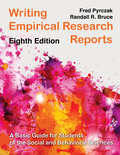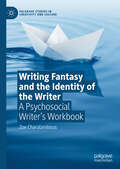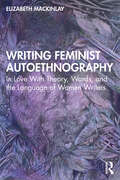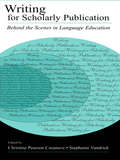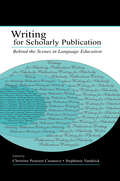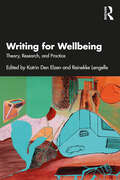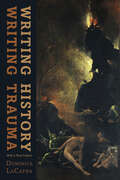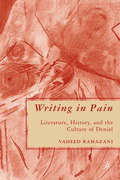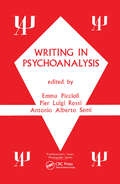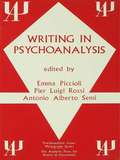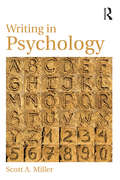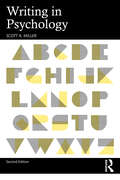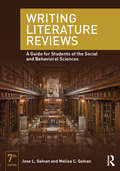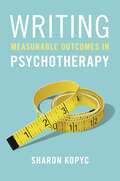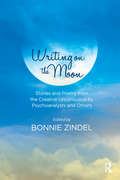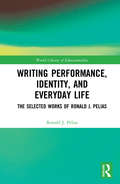- Table View
- List View
Writing Empirical Research Reports: A Basic Guide for Students of the Social and Behavioral Sciences
by Fred Pyrczak• Designed for students who will be writing research proposals, reports, theses, and dissertations. • The 15 chapters cover 191 guidelines for effective scientific writing. The guidelines are fully illustrated with easy-to-follow examples. • The guidelines describe the types of information that should be included, how this information should be expressed, and where various types of information should be placed within a research report. • End-of-chapter questions help students master the writing process.
Writing Empirical Research Reports: A Basic Guide for Students of the Social and Behavioral Sciences
by Fred Pyrczak• Designed for students who will be writing research proposals, reports, theses, and dissertations. • The 15 chapters cover 191 guidelines for effective scientific writing. The guidelines are fully illustrated with easy-to-follow examples. • The guidelines describe the types of information that should be included, how this information should be expressed, and where various types of information should be placed within a research report. • End-of-chapter questions help students master the writing process.
Writing Fantasy and the Identity of the Writer: A Psychosocial Writer’s Workbook (Palgrave Studies in Creativity and Culture)
by Zoe CharalambousThis book presents the innovative pedagogy of Writing Fantasy: a method for exploring and shifting one’s identity as a writer. The book draws on qualitative research with undergraduate creative writing students and fills a gap in the literature exploring creative writing pedagogy and creative writing exercises. Based on the potential to shift writer identity through creative writing exercises and the common ground that these share with the stance of the Lacanian analyst, the author provides a set of guidelines, exercises and case studies to trace writing fantasy, evidenced in one’s creative writing texts and responses about creative writing. This innovative work offers fresh insights for scholars of creativity, Lacan and psychosocial studies, and a valuable new resource for students and teachers of creative writing.
Writing Feminist Autoethnography: In Love With Theory, Words, and the Language of Women Writers
by Elizabeth MackinlayWriting Feminist Autoethnography explores the personal-is-political relationship between autoethnography and feminist theory and practice. Each chapter introduces the lives and works of a range of feminist thinkers and writers and considers the ways in which their thinking and writing might come to be in relation with our own personal-is-political thinking and writing work as feminist autoethnographers. The book begins with an acknowledgement of the author’s positionality as a white-settler-colonial-woman in relation with Yanyuwa, Garrwa, Mara and Kudanji Aboriginal women. This positionality has continued to resonate deeply with the responses and sensibilities the author holds as a feminist autoethnographer to move beyond coloniality. She explores the writing of Virginia Woolf, Simone Weil, Simone de Beauvoir, Hélène Cixous, Kathleen Stewart, bell hooks and Ruth Behar, with critical affect to embrace, embody and engage with feminist thinking, wondering and feeling. The book creatively and performatively explores what it means to live a feminist life as an autoethnographer. This book will define and conceptualize feminist autoethnography for all qualitative researchers, especially those interested in critical autoethnography, and scholars in gender studies and communication.
Writing Feminist Autoethnography: In Love With Theory, Words, and the Language of Women Writers
by Elizabeth MackinlayWriting Feminist Autoethnography explores the personal-is-political relationship between autoethnography and feminist theory and practice. Each chapter introduces the lives and works of a range of feminist thinkers and writers and considers the ways in which their thinking and writing might come to be in relation with our own personal-is-political thinking and writing work as feminist autoethnographers. The book begins with an acknowledgement of the author’s positionality as a white-settler-colonial-woman in relation with Yanyuwa, Garrwa, Mara and Kudanji Aboriginal women. This positionality has continued to resonate deeply with the responses and sensibilities the author holds as a feminist autoethnographer to move beyond coloniality. She explores the writing of Virginia Woolf, Simone Weil, Simone de Beauvoir, Hélène Cixous, Kathleen Stewart, bell hooks and Ruth Behar, with critical affect to embrace, embody and engage with feminist thinking, wondering and feeling. The book creatively and performatively explores what it means to live a feminist life as an autoethnographer. This book will define and conceptualize feminist autoethnography for all qualitative researchers, especially those interested in critical autoethnography, and scholars in gender studies and communication.
Writing for Scholarly Publication: Behind the Scenes in Language Education
by Christine Pears Casanave Stephanie VandrickThis collection of first-person essays by established authors provides a wealth of support and insights for new and experienced academic writers in language education and multicultural studies. Although writing for publication is becoming increasingly important as these fields become both more professional and more competitive, few scholars talk candidly about their experiences negotiating a piece of writing into print. These essays will help researchers, practitioners, and graduate students expand their understanding of what it means--professionally and personally--to write for publication. Carefully crafted, focused, and provocative, the chapters in this volume document authors' experiences with a range of practical, political, and personal issues in writing for publication. Many portray the hardship and struggle that are not obvious in a finished piece of writing. Readers are encouraged to resonate with the events and issues portrayed, and to connect the narratives to their own lives. Practical information, such as contact information for journal and book publishers, manuscript guidelines, and useful books are included in appendices. Although organized thematically, the essays in Writing for Scholarly Publication: Behind the Scenes in Language Education overlap in many ways as each author considers multiple issues: *In the Introduction, the editors discuss key aspects of writing for scholarly publication, such as writing as situated practice, issues faced by newcomers, the construction of personal identity through writing, writing and transparency, facets of the interactive nature of scholarly writing, and intertwined political issues. *Part I focuses on issues and concerns faced by "Newcomers." *In Part II, "Negotiating and Interacting," the essays closely examine the interactions among authors, editors, manuscript reviewers, and collaborators; these interactions tend to be the least often discussed and these essays therefore offer readers fascinating insights into the sensitive social, political, and personal relationships among the many players in the scholarly writing game. *"Identity Construction" is addressed in Part III, where authors share their experiences with and reflections on the ways that professional writing helps them construct their identities as writers and scholars. *The essays in Part IV, "From the Periphery," help redefine what the notion of "periphery" might mean, from a concept with a negative connotation of "outsider" to a positive connotation of active and unconventional participant.
Writing for Scholarly Publication: Behind the Scenes in Language Education
by Christine Pearson Casanave Stephanie VandrickThis collection of first-person essays by established authors provides a wealth of support and insights for new and experienced academic writers in language education and multicultural studies. Although writing for publication is becoming increasingly important as these fields become both more professional and more competitive, few scholars talk candidly about their experiences negotiating a piece of writing into print. These essays will help researchers, practitioners, and graduate students expand their understanding of what it means--professionally and personally--to write for publication. Carefully crafted, focused, and provocative, the chapters in this volume document authors' experiences with a range of practical, political, and personal issues in writing for publication. Many portray the hardship and struggle that are not obvious in a finished piece of writing. Readers are encouraged to resonate with the events and issues portrayed, and to connect the narratives to their own lives. Practical information, such as contact information for journal and book publishers, manuscript guidelines, and useful books are included in appendices. Although organized thematically, the essays in Writing for Scholarly Publication: Behind the Scenes in Language Education overlap in many ways as each author considers multiple issues: *In the Introduction, the editors discuss key aspects of writing for scholarly publication, such as writing as situated practice, issues faced by newcomers, the construction of personal identity through writing, writing and transparency, facets of the interactive nature of scholarly writing, and intertwined political issues. *Part I focuses on issues and concerns faced by "Newcomers." *In Part II, "Negotiating and Interacting," the essays closely examine the interactions among authors, editors, manuscript reviewers, and collaborators; these interactions tend to be the least often discussed and these essays therefore offer readers fascinating insights into the sensitive social, political, and personal relationships among the many players in the scholarly writing game. *"Identity Construction" is addressed in Part III, where authors share their experiences with and reflections on the ways that professional writing helps them construct their identities as writers and scholars. *The essays in Part IV, "From the Periphery," help redefine what the notion of "periphery" might mean, from a concept with a negative connotation of "outsider" to a positive connotation of active and unconventional participant.
Writing for Wellbeing: Theory, Research, and Practice
by Katrin Den Elzen Reinekke LengelleWriting can support our wellbeing even under the most difficult life circumstances, helping us to adapt to significant change, make sense of loss, improve our physical and emotional resilience, and foster personal growth. Numerous studies of Expressive Writing have confirmed this, and there are other established methodologies for practice. However, to date, few accounts have offered detailed descriptions showing how and why putting pen to paper can be so beneficial. This book delves deeply into the landscape of Writing-for-wellbeing and demonstrates the transformative power of writing in a wide range of contexts. Topics include personal trauma narratives within the Humanities; a participatory Writing-for-wellbeing study that demonstrates the effectiveness of writing in the context of grief and loss; surprise as the hidden mainspring of poetry's therapeutic potency; the empowerment and healing potential offered by Black women’s blogs; playwriting positioning LGBTQIA+ identities as positive through stories of belonging; how writing workshops have helped newly literate Indigenous adults and other participants in the Australian outback; and how the smuggled writings of Behrouz Boochani have enabled global witnessing of the stories of refugees held in offshore detention. This resource sets out the theory and research at the foundation of Writing-for-wellbeing in close relation to full and engaging accounts of practice. It aims to make the topic accessible and affirms its place as an effective reconstructive practice alongside other expressive arts therapies, providing a holistic and inspiring resource for anyone wishing to practice, teach, or research Writing-for-wellbeing.
Writing for Wellbeing: Theory, Research, and Practice
Writing can support our wellbeing even under the most difficult life circumstances, helping us to adapt to significant change, make sense of loss, improve our physical and emotional resilience, and foster personal growth. Numerous studies of Expressive Writing have confirmed this, and there are other established methodologies for practice. However, to date, few accounts have offered detailed descriptions showing how and why putting pen to paper can be so beneficial. This book delves deeply into the landscape of Writing-for-wellbeing and demonstrates the transformative power of writing in a wide range of contexts. Topics include personal trauma narratives within the Humanities; a participatory Writing-for-wellbeing study that demonstrates the effectiveness of writing in the context of grief and loss; surprise as the hidden mainspring of poetry's therapeutic potency; the empowerment and healing potential offered by Black women’s blogs; playwriting positioning LGBTQIA+ identities as positive through stories of belonging; how writing workshops have helped newly literate Indigenous adults and other participants in the Australian outback; and how the smuggled writings of Behrouz Boochani have enabled global witnessing of the stories of refugees held in offshore detention. This resource sets out the theory and research at the foundation of Writing-for-wellbeing in close relation to full and engaging accounts of practice. It aims to make the topic accessible and affirms its place as an effective reconstructive practice alongside other expressive arts therapies, providing a holistic and inspiring resource for anyone wishing to practice, teach, or research Writing-for-wellbeing.
Writing History, Writing Trauma (Parallax: Re-visions of Culture and Society)
by Dominick LaCapraTrauma and its aftermath pose acute problems for historical representation and understanding. In Writing History, Writing Trauma, Dominick LaCapra critically analyzes attempts by theorists and literary critics to come to terms with trauma and with the crucial role post-traumatic testimonies—notably Holocaust testimonies—assume in thought and in writing. These attempts are addressed in a series of six interlocking essays that adapt psychoanalytic concepts to historical analysis, while employing sociocultural and political critique to elucidate trauma and its aftereffects in culture and in people. This updated edition includes a substantive new preface that reconsiders some of the issues raised in the book.
Writing History, Writing Trauma (Parallax: Re-visions of Culture and Society)
by Dominick LaCapraTrauma and its aftermath pose acute problems for historical representation and understanding. In Writing History, Writing Trauma, Dominick LaCapra critically analyzes attempts by theorists and literary critics to come to terms with trauma and with the crucial role post-traumatic testimonies�notably Holocaust testimonies�assume in thought and in writing. These attempts are addressed in a series of six interlocking essays that adapt psychoanalytic concepts to historical analysis, while employing sociocultural and political critique to elucidate trauma and its aftereffects in culture and in people. This updated edition includes a substantive new preface that reconsiders some of the issues raised in the book.
Writing in Pain: Literature, History, and the Culture of Denial
by V. RamazaniThis book argues that while pain is an irreducible neuro-physiological phenomenon, how pain is experienced is powerfully inflected by language and culture. Using Second Empire France after Napoleon III's seizure of power as a particularly revealing time of re-acculturation, it elaborates on the "culture of denial."
Writing in Psychoanalysis
by Francesco Barale Parthenope Bion Talamo John E. Gedo Patrick Mahony Henning Paikin Fausto Petrella Giorgio Sacerdoti Antonio Alberto SemiA beautiful and thoughtful collection of essays on reading, writing and learning, Writing and Psychoanalysis grows out of a colloquium. The results are wondrous and impact on the reader at many different levels. In the act of writing, we all discover something about what we know previously unknown to us, and we learn more about our inner world that we knew before we set pen to paper (or hand to computer). Patrick Mahony goes so far as to argue that Freud's self-analysis was essentially a "writing cure." Writing in Psychoanalysis is the first volume in the projected Monograph Series, Psychoanalytic Issues, the Rivista di Psicoanalisi (the Journal of the Italian Psychoanalytical Society) is undertaking in conjunction with Karnac Books. This series constitutes a major effort to bring about a dialogue among psychoanalysts who while ultimately bound together by a common psychoanalytic heritage nonetheless are separated in their thinking by different idioms, whether linguistic or theoretical. While featuring writers of very different idioms, this series will also present a venue to make some important Italian voices known to English speaking analysts.
Writing in Psychoanalysis
by Emma Piccioli Pier L. Rossi Antonio A. SemiA beautiful and thoughtful collection of essays on reading, writing and learning, Writing and Psychoanalysis grows out of a colloquium. The results are wondrous and impact on the reader at many different levels. In the act of writing, we all discover something about what we know previously unknown to us, and we learn more about our inner world that we knew before we set pen to paper (or hand to computer). Patrick Mahony goes so far as to argue that Freud's self-analysis was essentially a "writing cure." Writing in Psychoanalysis is the first volume in the projected Monograph Series, Psychoanalytic Issues, the Rivista di Psicoanalisi (the Journal of the Italian Psychoanalytical Society) is undertaking in conjunction with Karnac Books. This series constitutes a major effort to bring about a dialogue among psychoanalysts who while ultimately bound together by a common psychoanalytic heritage nonetheless are separated in their thinking by different idioms, whether linguistic or theoretical. While featuring writers of very different idioms, this series will also present a venue to make some important Italian voices known to English speaking analysts.
Writing in Psychology
by Scott A. MillerThis book helps readers become better writers of psychology and better writers in general. After reading thousands of course papers, theses, and dissertations, Dr. Miller knows and addresses the issues that students find most challenging when writing about psychology. Written with the utmost flexibility in mind, the chapters can be read in any order. More comprehensive than similar texts, this book provides detailed coverage of how to write empirical reports, research proposals, and literature reviews, and how to read meta-analyses. Readers will also find invaluable strategies for improving one’s writing including how to adopt an engaging yet accurate style, thorough coverage of grammatical and word use rules that govern writing in general, and the APA (American Psychological Association) rules that govern the expression of that content. Readers will appreciate these helpful learning tools: Describes the most common APA style rules encountered and/or highlights references to the Manual when more detailed knowledge is required. Numerous examples from journal articles that help readers gain a clearer understanding of content they will encounter in writing psychological reports. Chapter exercises that provide an opportunity to apply the points conveyed in each chapter. Examples of the most common mistakes made by students and how to avoid them and best practices for improving one’s writing. Tables that help readers gain a clearer understanding of the new standards in the APA Publications Manual, 6th ed (Appendix A). Errors in APA Style exemplified via an improperly formatted paper and another version noting corrections pertaining to APA style and grammar, to highlight the most common pitfalls encountered by students (Appendix B). Ideal for courses on writing in psychology or as a supplement for graduate or advanced undergraduate courses in research design or research methods, this book also serves as a resource for anyone looking for guidance on how to write about psychological content.
Writing in Psychology
by Scott A. MillerThis book helps readers become better writers of psychology and better writers in general. After reading thousands of course papers, theses, and dissertations, Dr. Miller knows and addresses the issues that students find most challenging when writing about psychology. Written with the utmost flexibility in mind, the chapters can be read in any order. More comprehensive than similar texts, this book provides detailed coverage of how to write empirical reports, research proposals, and literature reviews, and how to read meta-analyses. Readers will also find invaluable strategies for improving one’s writing including how to adopt an engaging yet accurate style, thorough coverage of grammatical and word use rules that govern writing in general, and the APA (American Psychological Association) rules that govern the expression of that content. Readers will appreciate these helpful learning tools: Describes the most common APA style rules encountered and/or highlights references to the Manual when more detailed knowledge is required. Numerous examples from journal articles that help readers gain a clearer understanding of content they will encounter in writing psychological reports. Chapter exercises that provide an opportunity to apply the points conveyed in each chapter. Examples of the most common mistakes made by students and how to avoid them and best practices for improving one’s writing. Tables that help readers gain a clearer understanding of the new standards in the APA Publications Manual, 6th ed (Appendix A). Errors in APA Style exemplified via an improperly formatted paper and another version noting corrections pertaining to APA style and grammar, to highlight the most common pitfalls encountered by students (Appendix B). Ideal for courses on writing in psychology or as a supplement for graduate or advanced undergraduate courses in research design or research methods, this book also serves as a resource for anyone looking for guidance on how to write about psychological content.
Writing in Psychology
by Scott A. MillerThe second edition of Writing in Psychology by Scott A. Miller is a comprehensive guide to addressing the most challenging issues that students face while writing about psychology, including what to say and how to say it. It offers practical tools to overcome the challenges and create an engaging work. The book is a valuable resource for helping readers become better writers of psychology with the aid of various helpful learning tools, which provide detailed coverage of how to write empirical reviews, research proposals, literature reviews, term papers, and posters. It examines examples from journal articles that give readers a grasp of the content they will encounter in writing psychological reports. Furthermore, it includes exercises that provide an opportunity to apply the points conveyed in each chapter, examples of ways to avoid the most common mistakes made by students, and a guide to the best practices for improving one’s writing. Readers will also develop a thorough understanding of how to write in an engaging yet accurate style, using grammatical and word use rules that govern writing in general, and the rules of seventh edition APA (American Psychological Association) Publication Manual that determine the expression of that content. Throughout, the book emphasizes inclusion, diversity, and fair treatment of those with whom psychologists deal, in research and writing. The book will benefit anyone looking for guidance on how to write about psychological content. It is ideal for research scholars and psychology students as a primary text for writing in psychology courses and a supplement for graduate or advanced undergraduate courses in research design or research methods.
Writing in Psychology
by Scott A. MillerThe second edition of Writing in Psychology by Scott A. Miller is a comprehensive guide to addressing the most challenging issues that students face while writing about psychology, including what to say and how to say it. It offers practical tools to overcome the challenges and create an engaging work. The book is a valuable resource for helping readers become better writers of psychology with the aid of various helpful learning tools, which provide detailed coverage of how to write empirical reviews, research proposals, literature reviews, term papers, and posters. It examines examples from journal articles that give readers a grasp of the content they will encounter in writing psychological reports. Furthermore, it includes exercises that provide an opportunity to apply the points conveyed in each chapter, examples of ways to avoid the most common mistakes made by students, and a guide to the best practices for improving one’s writing. Readers will also develop a thorough understanding of how to write in an engaging yet accurate style, using grammatical and word use rules that govern writing in general, and the rules of seventh edition APA (American Psychological Association) Publication Manual that determine the expression of that content. Throughout, the book emphasizes inclusion, diversity, and fair treatment of those with whom psychologists deal, in research and writing. The book will benefit anyone looking for guidance on how to write about psychological content. It is ideal for research scholars and psychology students as a primary text for writing in psychology courses and a supplement for graduate or advanced undergraduate courses in research design or research methods.
Writing Literature Reviews: A Guide for Students of the Social and Behavioral Sciences
by Jose L. Galvan Melisa C. GalvanThis useful guide educates students in the preparation of literature reviews for term projects, theses, and dissertations. The authors provide numerous examples from published reviews that illustrate the guidelines discussed throughout the book. New to the seventh edition: Each chapter breaks down the larger holistic review of literature exercise into a series of smaller, manageable steps Practical instructions for navigating today’s digital libraries Comprehensive discussions about digital tools, including bibliographic and plagiarism detection software Chapter activities that reflect the book’s updated content New model literature reviews Online resources designed to help instructors plan and teach their courses (www.routledge.com/9780415315746).
Writing Literature Reviews: A Guide for Students of the Social and Behavioral Sciences
by Jose L. Galvan Melisa C. GalvanThis useful guide educates students in the preparation of literature reviews for term projects, theses, and dissertations. The authors provide numerous examples from published reviews that illustrate the guidelines discussed throughout the book. New to the seventh edition: Each chapter breaks down the larger holistic review of literature exercise into a series of smaller, manageable steps Practical instructions for navigating today’s digital libraries Comprehensive discussions about digital tools, including bibliographic and plagiarism detection software Chapter activities that reflect the book’s updated content New model literature reviews Online resources designed to help instructors plan and teach their courses (www.routledge.com/9780415315746).
Writing Measurable Outcomes in Psychotherapy
by Sharon KopycWriting Measurable Outcomes in Psychotherapy is an accessible and critical text for mental health counselors, clinical social workers, psychiatric nurses and others in behavioral health who write measureable objectives in treatment planning. Undergraduate and graduate students as well as those working in the field will find this an essential companion for writing meaningful and measurable goals and objectives for treatment plan outcomes. The key component in this text is the presentation of the CDRS (Cognitive Domain Rating Scale), an efficient and logical model that is presented as key to writing measurable objectives. The CDRS, based on Bloom's Taxonomy of Six Cognitive Domains, is rooted in cognitive psychology. It is a method to "situate client's thinking about their problem" and quickly identifies action(s) for creating measurable outcomes. This text is keen for neophyte and veteran therapists with illustrations of case examples and treatment plans and includes a discussion of Evidence Based Practices. It is a succinct text that integrates three key elements significant for successful psychotherapy: the therapeutic alliance, a person-centered approach and feedback by using outcome rating scales. . Case examples, dialogue and treatment plans are included and is aimed at future counselors, social workers, and psychologists as well as those already practicing in the field.
Writing Measurable Outcomes in Psychotherapy
by Sharon KopycWriting Measurable Outcomes in Psychotherapy is an accessible and critical text for mental health counselors, clinical social workers, psychiatric nurses and others in behavioral health who write measureable objectives in treatment planning. Undergraduate and graduate students as well as those working in the field will find this an essential companion for writing meaningful and measurable goals and objectives for treatment plan outcomes. The key component in this text is the presentation of the CDRS (Cognitive Domain Rating Scale), an efficient and logical model that is presented as key to writing measurable objectives. The CDRS, based on Bloom's Taxonomy of Six Cognitive Domains, is rooted in cognitive psychology. It is a method to "situate client's thinking about their problem" and quickly identifies action(s) for creating measurable outcomes. This text is keen for neophyte and veteran therapists with illustrations of case examples and treatment plans and includes a discussion of Evidence Based Practices. It is a succinct text that integrates three key elements significant for successful psychotherapy: the therapeutic alliance, a person-centered approach and feedback by using outcome rating scales. . Case examples, dialogue and treatment plans are included and is aimed at future counselors, social workers, and psychologists as well as those already practicing in the field.
Writing on the Moon: Stories and Poetry from the Creative Unconscious by Psychoanalysts and Others
by Bonnie ZindelWriting on the Moon: Stories and Poetry from the Creative Unconscious by Psychoanalysts and Others is a collection of the best works published over the past fifteen years in the Creative Literary Section of Psychoanalytic Perspectives, along with imaginative introductions by the author. Some writings are raw and honest, some are dark and access our primal being. Others, filled with beauty, illuminate the internal life, the playful mind, and unconscious doodlings that might otherwise remain unformulated.
Writing Performance, Identity, and Everyday Life: The Selected Works of Ronald J. Pelias
by Ronald J. PeliasWriting Performance, Identity, and Everyday Life invites the reader into Ronald J. Pelias’ world of artistic and everyday performance. Calling upon a broad range of qualitative methods, these selected writings from Pelias submerge themselves in the evocative and embodied, in the material and consequential, often creating moving accounts of their topics. The book is divided into four sections: Foundational Logics, Performance, Identity, and Everyday Life. Part I addresses the methodological underpinnings of the book, focusing on the ‘touchstones’ that inform Pelias’ work: performative, autoethnographic, poetic, and narrative methods. These directions push the researcher toward empathic engagement, a leaning toward others; using the literary to evoke the cognitive and affective aspects of experience; and an ethical sensibility located in social justice. Parts II–IV focus on artistic and everyday life performances, including discussions of the disciplinary shift from the oral interpretation of literature to the field of performance studies; empathy and the actor’s process; conceptions of performance; the performance of race, gender, and sexuality; and performances in interpersonal relations and academic circles. By the end, readers will see Pelias demonstrate the power of qualitative methods to engage and to present alternative ways of being. Pelias’ work shows us how to understand and feel the evocative strength of thinking performatively.
Writing Performance, Identity, and Everyday Life: The Selected Works of Ronald J. Pelias
by Ronald J. PeliasWriting Performance, Identity, and Everyday Life invites the reader into Ronald J. Pelias’ world of artistic and everyday performance. Calling upon a broad range of qualitative methods, these selected writings from Pelias submerge themselves in the evocative and embodied, in the material and consequential, often creating moving accounts of their topics. The book is divided into four sections: Foundational Logics, Performance, Identity, and Everyday Life. Part I addresses the methodological underpinnings of the book, focusing on the ‘touchstones’ that inform Pelias’ work: performative, autoethnographic, poetic, and narrative methods. These directions push the researcher toward empathic engagement, a leaning toward others; using the literary to evoke the cognitive and affective aspects of experience; and an ethical sensibility located in social justice. Parts II–IV focus on artistic and everyday life performances, including discussions of the disciplinary shift from the oral interpretation of literature to the field of performance studies; empathy and the actor’s process; conceptions of performance; the performance of race, gender, and sexuality; and performances in interpersonal relations and academic circles. By the end, readers will see Pelias demonstrate the power of qualitative methods to engage and to present alternative ways of being. Pelias’ work shows us how to understand and feel the evocative strength of thinking performatively.
